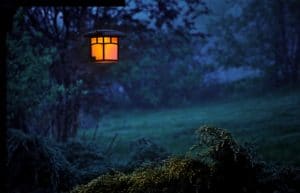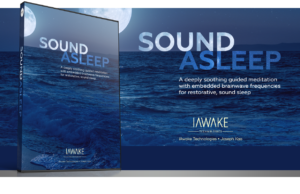Trouble Sleeping? Recapture the Lost Art of Deep, Restorative Sleep
 It was a few months after the birth of our second child that I came to truly understand the effects of long-term sleep deprivation. Constantly waking up at 1:00 or 3:00 a.m. soon turned daily life into a hazy blur. I’d often find myself lying in bed, anticipating the next round of crying, or later in the night, I’d be tossing and turning for ages after being woken up. It’s no fun whatsoever to drag yourself out of bed every morning with dark circles under your eyes. During this time, it became harder for me to focus and do high-quality, creative work, and I found myself becoming irrational, grouchy, and impatient over really trivial things.
It was a few months after the birth of our second child that I came to truly understand the effects of long-term sleep deprivation. Constantly waking up at 1:00 or 3:00 a.m. soon turned daily life into a hazy blur. I’d often find myself lying in bed, anticipating the next round of crying, or later in the night, I’d be tossing and turning for ages after being woken up. It’s no fun whatsoever to drag yourself out of bed every morning with dark circles under your eyes. During this time, it became harder for me to focus and do high-quality, creative work, and I found myself becoming irrational, grouchy, and impatient over really trivial things.
Of course, there were wonders and joys through this period of my life. It wasn’t all bad, by any means, and I still think back to those days very fondly. But I was acutely aware that I was functioning at about sixty percent of my normal capacity. So I thought to myself, what can I do to improve this situation? How can I start sleeping better? The ironic thing is that in my work as a hypnotherapist, I’d actually treated many clients for insomnia. In fact, a few years back I’d even given talks on overcoming sleep problems. It was high time I put some of my own advice into practice!
Excerpt from a talk I gave on how to sleep more soundly and deeply…
“The truth about restorative sleep, and learning to sleep more deeply and soundly, is that your body has hundreds of thousands of years of intuitive wisdom built into it. There are deep, primal instincts within you, which guide you in what to eat and drink, when to exercise, and when to sleep. These instincts have worked really well for our species throughout history. But, they can be tricked. They can be disrupted. As soon as you have electric lights everywhere, it starts to disrupt your body clock—just like the way moths start to mistake electric lights for the moon; their inner guidance system gets lost.
 I remember visiting some friends who live in the middle of a forest in the south of England. They live with their children in a handmade yurt, which is like a giant tent with a wooden lattice structure around it. It’s a real alternative lifestyle, where they grow organic salad and sell it to local restaurants, and it has taken hard work on their part to make it happen. They have a wooden kitchen outside, so they prepare their meals out in the elements. I remember watching their youngest child potter around picking raspberries and thinking, what a lovely place to grow up.
I remember visiting some friends who live in the middle of a forest in the south of England. They live with their children in a handmade yurt, which is like a giant tent with a wooden lattice structure around it. It’s a real alternative lifestyle, where they grow organic salad and sell it to local restaurants, and it has taken hard work on their part to make it happen. They have a wooden kitchen outside, so they prepare their meals out in the elements. I remember watching their youngest child potter around picking raspberries and thinking, what a lovely place to grow up.
Now to some people, this seems a crazy way to live, but on the other hand spending hours on the sofa in front of a flat screen TV that beams blue light directly into our retinas before bed is arguably a much more crazy lifestyle. The blue light emitted by electronic screens interferes with the melatonin levels in your brain, and it can significantly disrupt your sleep cycle. So it’s a really good idea to reduce your exposure to blue light at night, and to dim down the lights at night in general.
 Also, watching thrillers and tense dramas, news stories about war, clips with rapid-editing techniques, cliffhangers, and other methods of trying to keep you alert and engaged in the film or show—none of these are helpful for creating an environment conducive for settling down to sleep. The blinking red notifications of Facebook, the alerts from Twitter and other social media sites, or the pings of an email arriving are all very much akin to the technology used to keep people hooked on slot machines. It’s like carrying around a loud, blaring, digitized Las Vegas casino, compacted into your smartphone. Of course, these things have their uses, just as thinking in vivid, exciting, creative ways has its uses. Everything has a time and a place. But when it comes to evening time, when it comes to restorative sleep, we need to learn to dial everything down.
Also, watching thrillers and tense dramas, news stories about war, clips with rapid-editing techniques, cliffhangers, and other methods of trying to keep you alert and engaged in the film or show—none of these are helpful for creating an environment conducive for settling down to sleep. The blinking red notifications of Facebook, the alerts from Twitter and other social media sites, or the pings of an email arriving are all very much akin to the technology used to keep people hooked on slot machines. It’s like carrying around a loud, blaring, digitized Las Vegas casino, compacted into your smartphone. Of course, these things have their uses, just as thinking in vivid, exciting, creative ways has its uses. Everything has a time and a place. But when it comes to evening time, when it comes to restorative sleep, we need to learn to dial everything down.
Quiet everything down.
Turn off the chatter, turn off the TV, and listen to the silence of the room. Take some time to rest properly.
 The last time I stayed with the friends who live in the forest, we actually spent the evening in a small caravan because they were doing some construction work on the yurt itself. They just had one candle lit in the caravan, so we were chatting in almost complete darkness. As I looked around at the shadows, I was surprised at how comfortable everything felt. We could see the stars through the window; there were trees all around. My eyes were bathed in a soothing sense of darkness, with just the faintest possible glow of candlelight. It was like my whole body was settling down softly for a deeper, more restful, more natural sleep. I noticed I felt sleepier—far sleepier—than I ever would normally have felt in my brightly lit living room at home.
The last time I stayed with the friends who live in the forest, we actually spent the evening in a small caravan because they were doing some construction work on the yurt itself. They just had one candle lit in the caravan, so we were chatting in almost complete darkness. As I looked around at the shadows, I was surprised at how comfortable everything felt. We could see the stars through the window; there were trees all around. My eyes were bathed in a soothing sense of darkness, with just the faintest possible glow of candlelight. It was like my whole body was settling down softly for a deeper, more restful, more natural sleep. I noticed I felt sleepier—far sleepier—than I ever would normally have felt in my brightly lit living room at home.
We chatted quietly, having been out in the fresh air all day, surrounded by nature, and there came a point when I yawned and said to myself, “Okay, time for sleep.” I said goodnight to everyone and found I slept more deeply and soundly that night than I had in ages. The next day, too, I felt so much better. Renewed somehow. Like my body had experienced the kind of deep, restorative sleep it had been craving. I noticed I had more energy, my mood was brighter, my brain felt like it was functioning more optimally. Even the colors seemed brighter. I began to wonder, what would happen if I started sleeping like this night after night? How much better would I feel? How much more could I accomplish if I chose to wind down properly for sleep each night?
The basic steps to make this a reality are all very intuitive and straightforward. It’s just like how you would settle a child for sleep. You gradually calm things down before bedtime. You read them a bedtime story; you dim the lights; you do everything you can to help them quiet and wind down for sleep.
Your Body Already Knows How to Prepare for Sleep
 What’s more, your body intuitively understands how to prepare for things in advance. You have hundreds of thousands of years of evolutionary wisdom within each and every cell of your body, and even before you awaken in the morning, your body is already preparing to wake up. Hormones and neurotransmitters begin to adjust and brain waves shift quite some time before you actually awaken. In the same way, quite some time before breakfast, your stomach is already getting ready for digestion. It knows what to expect, because it knows when you typically eat.
What’s more, your body intuitively understands how to prepare for things in advance. You have hundreds of thousands of years of evolutionary wisdom within each and every cell of your body, and even before you awaken in the morning, your body is already preparing to wake up. Hormones and neurotransmitters begin to adjust and brain waves shift quite some time before you actually awaken. In the same way, quite some time before breakfast, your stomach is already getting ready for digestion. It knows what to expect, because it knows when you typically eat.
So, an hour or so before bedtime, your body is already making preparations for sleep. That time has a name: “Winding Down Time.” Winding Down Time has nothing to do with bright screens and stimulation. It has to do with darkness, comfort, one candle in a caravan, stories, settling down. When the time comes, you say to yourself, “Time to wind down for sleep.” And when you think that to yourself every night, you can see yourself beginning to look healthier and happier. It feels good to choose to make this a reality.
You can start by calmly saying to yourself, “Okay, let’s do it.” Simply relax with each step you take. Turn off any screens. Slow down. Brush your teeth. Undress. Dim the lights. Read a story perhaps, or listen to an audiobook. It’s like settling a child for sleep or giving an animal the environment it needs for deep, sound sleep. You create a space that’s conducive for deep rest. A place of quiet, calm, and darkness.
 You can quiet down on the inside, too. Do you know what your own inner voice would sound like with more of a yawn in
You can quiet down on the inside, too. Do you know what your own inner voice would sound like with more of a yawn in
it? You can relax with each page you turn in a book. Or, if you play some soothing music, you can relax with each sound you hear. You’ll find that lying in bed becomes something that allows you to relax even deeper. As each thought in your mind softens, you relax ever more deeply. When clients who have seen me for insomnia have consistently implemented this approach, they start to tap into their natural ability to settle down for deep sleep.
This allows us to feel so much more refreshed, healthier, and vibrant each and every day, because everything comes into balance. We find we’re feeling like we always thought we should feel. Really healthy. Really well. Having set healthy boundaries around modern technology, we’re preserving our primal, instinctive right to sound, restorative sleep, each and every night.
That’s a good thing to know, right?”
Experiencing Deeper, More Restorative Sleep Now
I realized I’d completely stopped giving myself proper winding down time since becoming a father. I’d actually fallen back into old habits of watching late night TV, browsing the internet, or flicking through my phone. So my partner and I created a rule for ourselves that at 9:30 p.m., we’d turn off all electronic devices. No phones, no TV, no computers. We’d dim the lights, we’d read, and we’d chat. It was such a good thing for us to do. It brought us closer together and allowed us to connect better.
Once I was in bed, I’d listen to half an hour of soft, soothing music though headphones. I used my knowledge of brainwave entrainment to layer into this music some rhythmic sound pulses, called binaural beats. Research has found that slow, rhythmic sounds, including binaural beats, can guide your brain waves into slower, calmer frequencies, which are more conducive for relaxation and sleep. Binaural beats are essentially training wheels for the mind. In my experience, they make it much easier to go into states of deep relaxation and inner focus.
 I’d used binaural beats and brainwave entrainment for many years to support my meditation practice, but for some reason I’d not been using them to help myself sleep. I also practiced a deep relaxation exercise as I listened. I softened my internal voice and relaxed each part of my body, step by step. I breathed smoothly and deeply and imagined I was strolling through a beautiful, calming inner landscape. Within a few nights, I found I was rapidly sinking down into deep sleep as soon as I put on the headphones.
I’d used binaural beats and brainwave entrainment for many years to support my meditation practice, but for some reason I’d not been using them to help myself sleep. I also practiced a deep relaxation exercise as I listened. I softened my internal voice and relaxed each part of my body, step by step. I breathed smoothly and deeply and imagined I was strolling through a beautiful, calming inner landscape. Within a few nights, I found I was rapidly sinking down into deep sleep as soon as I put on the headphones.
Now the reality of the situation was that I’d still sometimes be woken up by our son. But overall, my sleep quality became much, much better. I was drifting off to sleep much faster at night, and I got back to sleep much more easily than I had been doing. This, in turn, helped me feel so much brighter, more energized, and more clear-headed during the day. I felt better able to cope with the challenges of parenthood and to enjoy the magic of it. The deeper, more restorative sleep I was getting allowed me to feel like my old self again.
3 things you can do to experience deeper sleep at night are:
- Commit to a winding down ritual at least an hour before bed. Make sure the lights are dim and that you are doing something relatively unstimulating, like reading a book. Do not look at any electronic screens. Create a place that is quiet, dark, cozy, and restful, like you would create for a child to prepare them for sleep.
- Use gentle, rhythmic music to lull your brain waves into a slower, sleepier rhythm. People have used music throughout history to help themselves enter different states of consciousness. Music embedded with binaural beats is a modern example of this ancient art of “sound medicine.”
- Practice a deep relaxation exercise when in bed. Breathe slowly and deeply, and relax your muscles in turn, from the top of your head to the tips of your toes. Bring to mind memories of beautiful places you have visited. Repeat as needed.
It’s important to be patient. If you wind down and relax every night in bed, it will inevitably help your sleep quality over time. That doesn’t mean you’ll instantly be out like a light, but by making small adjustments to your nightly routine, you’ll find that you gradually experience deeper and deeper sleep. This is something your body knows how to do. It’s just a case of reminding yourself how to do it.
___________________________________________
 If you found this article useful, you may be interested in my new, guided, audio meditation Sound Asleep. It contains gentle, dream-like suggestions for relaxation and sleep, with layers of binaural beats and immersive sound textures, designed to induce sound, restorative sleep.
If you found this article useful, you may be interested in my new, guided, audio meditation Sound Asleep. It contains gentle, dream-like suggestions for relaxation and sleep, with layers of binaural beats and immersive sound textures, designed to induce sound, restorative sleep.
___________________________________________
 Joseph Kao, creator of Profound Releasing, Profound Renewal, and Sound Asleep, is a hypnotherapist and a solution-focused therapist with a private practice in Cambridge, UK. Joseph was the co-developer of an acclaimed course on conversational hypnosis, and he regularly teaches hypnotherapy and psychotherapy to other therapists. He has also been the head scriptwriter for over 800 professional hypnotherapy recordings.
Joseph Kao, creator of Profound Releasing, Profound Renewal, and Sound Asleep, is a hypnotherapist and a solution-focused therapist with a private practice in Cambridge, UK. Joseph was the co-developer of an acclaimed course on conversational hypnosis, and he regularly teaches hypnotherapy and psychotherapy to other therapists. He has also been the head scriptwriter for over 800 professional hypnotherapy recordings.
Joseph was drawn to the world of philosophy, meditation, and brainwave entrainment technology from an early age, and he’s had a daily meditation practice since 1998.
___________________________________________
This blog was edited by Heidi Mitchell, who has been working with iAwake’s CEO, John Dupuy, for over 10 years as assistant and editor. John introduced her to Integral theory and practice and brainwave entrainment enhanced meditation in 2007. Heidi is also a freelance editor of nonfiction books, blogs, and web sites. She can be reached at www.heidimitchelleditor.com.
Leave a Comment
You must be logged in to post a comment.

Leave your comments below